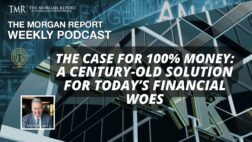Will Silver Follow Gold to Record Highs? by Northwest Territorial Mint Staff
Gold reached all-time (non-adjusted) highs in 2009 and has maintained above $1,100/oz. into the first months of 2010. Yet, why hasn’t silver peaked as well? Though it rose 45% in 2009, silver is hovering around $17/oz. and still well below its 1980 peak of $50/oz. Northwest Territorial Mint recently asked some experts in the silver industry to give us their view of silver — where it’s been and where it’s going.
How would you explain silver’s relationship to gold? Hugh Clarke, vp of corporate communication for Endeavour Silver Corp, notes that the silver/gold relationship was once the opposite of what it is today, with silver being the highly prized metal at one point in history. “Silver is known as the “Poor Man’s Gold” although most of your readers might be surprised to learn that 4,500 years ago silver was considered more valuable than gold, as the supply of silver was scarce. With the discovery of large silver deposits in present-day Spain, Turkey and other countries, silver became more plentiful than gold and lost its price dominance. The big discoveries in the New World after 1500 AD hastened silver’s price decline, relative to gold. As civilizations evolved, both metals were used as currency and a historical relationship was established. In recent history, gold has been much more valuable and for those people seeking safety or insurance; their first choice is gold but if the gold price is too dear, they’ll buy silver.”
Jeffrey Christian, managing director CPM Group, describes the inventory amount and interchangeable relationship of the two metals. “Gold and silver have a loose relationship. They share a long history of being used as money, extending back five millennia. They also share many physical and chemical properties, which gives them some substitutability. For example, both silver and gold can be used in some electronic applications, and in some medical and dental devices. Both are immune to corrosion from many weaker acids. Both have enormous inventories, much of it in jewelry and statuary, built up over the past 5,000 years.” David Morgan, founder of Silver Investors, points to the wealth-protecting properties that have drawn investors to the metals over the millennia. “Both have been real wealth and safe havens for all of recorded history. Silver and gold were both consider money until the advent of the electrical and now electronic age when silver took on the primary role as an ‘industrial’ metal.” What does being known as an “industrial” metal do for silver’s investment value?
As Clarke points out, silver has gained widespread use throughout many industries in recent years, “Over the past two decades, the use of silver in industrial applications has exploded. I call silver “The Miracle Metal” because of its unique properties. It’s the best conductor of electricity, the best conductor of heat, it’s the most reflective of metals, it’s malleable, ductile and it’s beautiful and it also has anti-bacterial properties. The applications for silver in everyday living touch everybody on this planet. The US Patent Office issues more patents for silver-based products than any other metal, by a very wide margin.” Christian points to the dual role that silver plays as a unique strength. “CPM Group often says that gold clearly trades as a financial asset would. It trades like currencies and bonds. Silver straddles the financial markets and the industrial commodities markets. It is both. It shares some market characteristics with gold, like the enormous inventories built up over 5,000 years, and the high ratio of derivatives to annual physical supply and demand changes.
Silver also shares other characteristics with industrial commodities such as oil and copper. This duality of nature sometimes helps support silver prices. Industrial demand sometimes will rise for silver at a time when financial interest in gold and silver are waning, which is not uncommon in the early stages of an economic expansion.” What’s the value of the gold/silver ratio for investment purposes? Clarke doesn’t see much value in the gold/silver ratio. “For many, many years the silver/gold ratio was 16:1, for the past few years it’s been in the 50-80:1 range, reaching a high of around 100:1. At present it’s about 60:1. It is what it is. The gold/silver ratio is meaningless to me. What is meaningful to me is the fact we are in the midst of a powerful bull market for gold and silver and a great many factors, including supply-and-demand and currency debasement — amongst others — lead me to believe that we are not even close to the top. The best is yet to come.” Christian concurs with Clarke’s view on the ratio, “At CPM Group we largely ignore the gold/silver ratio. It is largely meaningless as a trading or investment guide. The gold/silver ratio has ranged between 16:1 and 100:1 over the four decades of free gold and silver prices. Some people will point to the average over this time, saying that the price needs to revert to it. There are no economic, geologic, or mathematic reasons to suggest that. People will speak about the reversion to the mean, but they misunderstand what that term means. The concept of reversion to the mean refers to the idea that the return on investments should revert to their mean over the long run. It says nothing about the absolute dollar value, level, or ratio of those investments. Worse still: The concept that all investments revert to their mean return is unsubstantiated by data across financial markets. It is a belief, like the idea that aliens from outer space brought humans to colonize the Earth. You can believe if it helps you to sleep, but investing based on rational expectations has always been just fine for me.” Morgan takes the opposite view on the ratio and notes that he has found success in trading it, “One of the most important methods to increase your gold holdings (or silver if you prefer) is by trading the ratio — I have done this successfully the entire bull market so far.” Using 1980 as the benchmark, gold has passed its (non-adjusted) highs in 2009, but why hasn’t silver?
According to Clarke, the global economic crisis may provide investors with an opportunity to get into silver at a good price. “With the credit crunch of 2007-2008 and the ensuing global recession, there was pressure on silver as it was thought that industrial demand would slacken. The silver price got crushed, reaching a low of around $8.00 an ounce in late 2008. Silver is playing catch-up and even though I love gold, I’m convinced that the silver price will out-perform gold’s price.” While seeing strong silver demand in North America, Christian points to global trends being more unclear on silver’s outlook. “Our view is that the gold price has risen further this time around than silver because gold is seen more broadly as a financial asset and a form of quasi-money. In the silver market, demand has been strong in the United States, which has a strong tradition of investing in silver. It has been moderately strong in Canada and a few other places. European and Japanese investors tend not to turn to silver in times such as we recently have experienced, but focus more on gold. In India and the Middle East investment demand has been higher for gold, but investors have been less interested in silver. In fact, there have been significant sales of silver jewelry and investment bars in the Middle East and India as investors have sought to take advantage of the higher prices.” Morgan thinks it may be a bit premature for silver to experience rapid growth, “It is way too early in the cycle for silver to move into an acceleration phase. However, a good study of the last cycle would give an accurate picture of how silver performs vs. gold in an inflationary environment.” … Hugh Clarke is vice president of corporate communications for Endeavour Silver Corp, a silver mining company focused on the growth of its silver production, reserves and resources in Mexico. Jeffrey Christian is managing director of CPM Group, a commodities market research, consulting, asset management, and investment-banking firm. David Morgan is founder of the Silver Investor and editor-in-chief of the monthly precious metals research guide, “The Morgan Report.”



